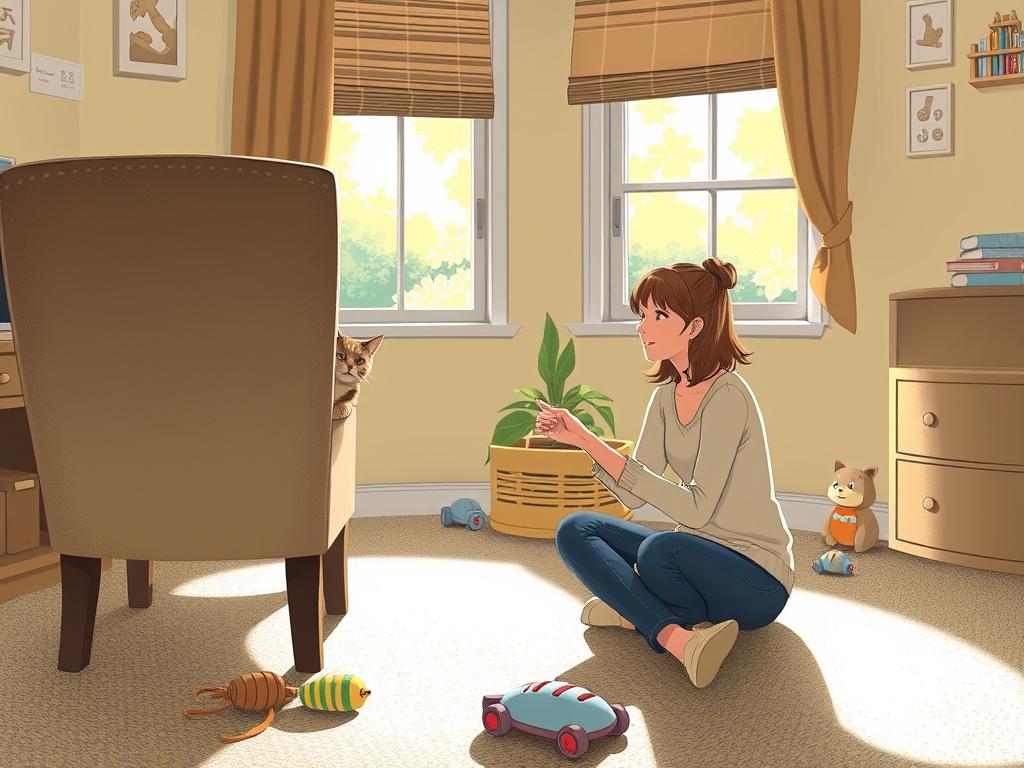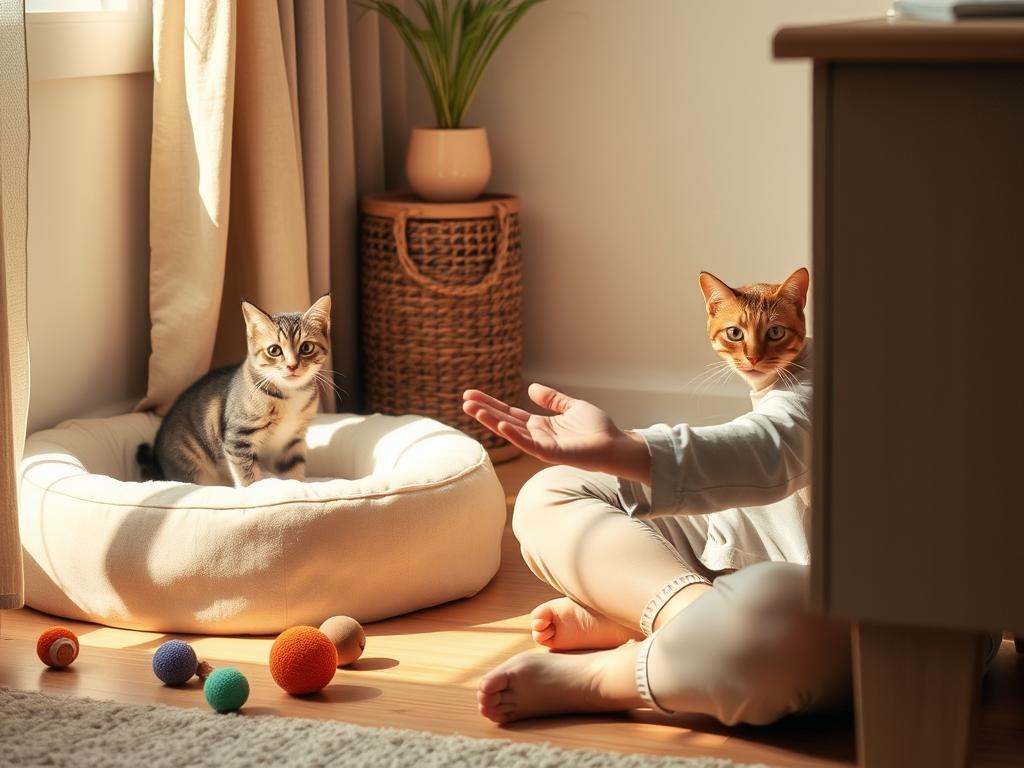Ever pondered why some cats appear unapproachable, retreating at the mere presence of humans? For many, the quest to bond with a shy or skittish cat is daunting. It’s essential to grasp their emotional and behavioral nuances to establish a lasting connection. This path demands patience and a soft approach, fostering a gradual sense of security and trust.
By recognizing the distinct traits of a shy or skittish cat, you can nurture deep, rewarding relationships. These connections are the foundation for joyful companionship.

Understanding Shy and Skittish Cats
A shy cat may show a natural hesitation to interact with their surroundings. This behavior can come from genetics, early social experiences, or past trauma. It’s crucial to understand feline behavior to help owners address these issues.
Genetics can shape a cat’s temperament, making some more reserved or wary. Inadequate socialization during key developmental periods can also make a cat skittish. Past trauma greatly affects a cat’s trust, causing them to fear new situations.
Cats, being prey animals, are naturally cautious. This is key for owners to understand when supporting a shy cat’s emotional needs. Recognizing their instinctual behaviors helps owners build trust through gentle interactions.
The following behaviors are common in shy or skittish cats:
- Hiding in safe spaces when feeling threatened
- Avoiding eye contact and retreating from social interactions
- Exhibiting defensive postures when approached
Understanding these behaviors is the first step in grasping a shy cat’s nature. With patience and compassion, owners can help their cats feel more at ease. This creates an environment where trust can grow.

The Importance of Patience in Building Trust
Understanding a cat’s natural instincts is crucial when building rapport, especially with shy or skittish ones. Gaining their trust requires patience and time. Each cat progresses at their own pace, and some may take longer to open up. Rushing this process can cause setbacks, as it may trigger their flight response.

Creating a safe and comfortable environment is key when working with shy cats. Letting them approach you on their terms helps them feel secure. Start with short interactions and gradually increase the time as they become more comfortable. Cat behaviorists often note that small victories, like a cat coming closer or sniffing your hand, are significant in building trust.
| Stage of Trust | Expected Timeframe | Signs of Progress |
|---|---|---|
| Initial Observation | 1-2 weeks | Cat watches from a distance |
| Curiosity | 2-4 weeks | Cat approaches within a few feet |
| Gradual Contact | 4-8 weeks | Cat allows gentle touch or pats |
| Full Bonding | 8+ weeks | Consistent cuddling and purring |
Patience and celebrating small victories are essential in enhancing your approach to shy cat interaction. Each step forward is a triumph, showing the value of taking your time. Building trust with a cat is a journey, not a race. Adopting this mindset helps in forging a lasting bond with your feline companion.
How to Create a Bond with a Shy or Skittish Cat and Gain Their Trust Over Time
Building a real connection with a shy cat demands patience and understanding. Start by setting up a calm environment. Keep the cat away from loud sounds and sudden movements. This peaceful space is key to making them feel safe, crucial for a lasting bond with pets.
Begin with gentle introductions. Sit where the cat feels safe, letting them come closer when ready. Learning their daily habits can reveal their likes. Timing your interactions when it’s quiet can improve bonding. A calm demeanor is vital in gaining trust from a skittish cat.
Speak softly when interacting with the cat. This gentle voice reassures them, making them feel less scared. Offering treats can also help create positive memories. Start by giving rewards from a distance, then gradually get closer as trust grows.
Watch the cat’s body language closely. This will help you know when they’re comfortable or not. Being consistent in your interactions builds trust. With patience and understanding, a bond with a shy cat will develop over time.
| Tips | Description |
|---|---|
| Safe Space | Create a quiet area with cozy hiding spots for the cat. |
| Gentle Introductions | Allow the cat to approach you on their terms. |
| Observation | Watch for signs of comfort or discomfort in the cat’s behavior. |
| Positive Reinforcement | Reward calming behavior with treats and praise. |
Identifying Your Cat’s Body Language
Understanding your cat’s body language is key to better communication and trust with a shy cat. Observing how a cat holds its body reveals its emotional state. Key indicators include:
- Tail Position: A high tail often signifies confidence, while a low or tucked tail indicates fear or submission.
- Ear Orientation: Forward-facing ears suggest interest and curiosity. Conversely, flattened ears mean your cat might feel threatened or scared.
- Eye Contact: Slow blinking can show trust, while wide eyes may indicate surprise or fear.
By becoming adept at recognizing these signals, pet owners can facilitate better interactions with their shy cats. Understanding feline signals allows for adjustments in behavior that foster a nurturing environment. Cats often communicate their comfort levels through their body posture. So, paying attention to these details can improve the bond between a cat and its owner.
Creating a Safe Space for Your Cat
Creating a safe space for a shy cat is crucial for boosting their confidence and comfort. A designated area can significantly reduce anxiety, making your cat feel secure. To enhance your home’s cat comfort zones, consider these elements:
- Quiet Areas: Choose a spot away from loud noises and foot traffic.
- Hiding Spots: Use cat condos, blankets, or boxes for hiding places.
- Soft Bedding: Add cozy bedding to encourage relaxation.
- Familiar Scents: Include items with familiar scents for emotional support.
- Vertical Spaces: Install shelves or a cat tree for safe observation.
By incorporating these elements, you create a sanctuary tailored to your shy cat’s needs. This provides security for pets.
A safe space lets your cat retreat and observe without feeling pressured. These comfort zones give them control and reduce stress. This fosters a trusting bond between you and your pet.
| Element | Benefits |
|---|---|
| Quiet Area | Minimizes distractions and stressors |
| Hiding Spots | Provides a sense of safety and escape |
| Soft Bedding | Enhances comfort and relaxation |
| Familiar Scents | Encourages emotional security |
| Vertical Spaces | Empowers observation and control |
Establishing a Routine to Build Comfort
Creating a structured cat daily routine is crucial for building feline comfort. A predictable schedule offers security to shy or skittish cats, helping them adjust to their environment. This predictability minimizes anxiety, allowing your cat to feel more at ease.
To facilitate this process, consider implementing the following elements into your routine:
- Feeding Times: Establish consistent meal times. This fosters a sense of reliability and allows your cat to anticipate when nourishment will be provided.
- Play Sessions: Schedule regular playtime. Engaging in fun activities not only strengthens your bond but also encourages interaction in a comfortable setting.
- Quiet Time: Incorporate downtime into the daily routine. This allows your cat to rest and recharge, essential for a skittish feline.
- Interaction Opportunities: Designate specific moments for gentle interactions and petting. Gradual exposure is key in establishing trust with a skittish cat.
By maintaining consistency in these areas, the environment becomes familiar, enabling your cat to feel more secure. This routine supports the overall goal of building feline comfort while establishing trust with a skittish cat.
Ways to Connect with a Shy Cat
Building a connection with a shy cat demands a gentle and engaging approach. It’s crucial to foster trust and comfort. There are various methods to explore, each aimed at helping the cat feel more at ease. These activities allow you to observe your cat’s reactions, guiding your approach as needed.
Consider these engaging activities:
- Reading Aloud: Choose a comfortable spot and read softly to your cat. The soothing sound of your voice can create a calming atmosphere, helping your cat to feel secure.
- Using Toys for Playfulness: Introduce interactive toys such as feather wands or laser pointers. Allow your cat to take the lead in play, which can build rapport while respecting their comfort zone.
- Allowing the Cat to Initiate Contact: Let your cat approach you when they feel ready. This builds confidence and reinforces that they are in control during your interactions.
Incorporate these ways to connect with a shy cat into your routine. By creating enjoyable experiences, you foster a nurturing relationship that enhances your cat’s comfort level. Always remember to observe their body language and reactions, adjusting your methods accordingly to support their unique personality.
| Activity | Description | Benefits |
|---|---|---|
| Reading Aloud | Softly read a book or magazine to your cat. | Creates a calming environment. |
| Interactive Toys | Introduce toys for engaging playtime. | Encourages playful interaction. |
| Initiation of Contact | Let the cat decide when to approach. | Fosters trust and confidence. |
Engaging in Interactive Playtime
Interactive playtime is key for building trust with shy or skittish cats. It stimulates their natural hunting instincts and strengthens the bond between you and your pet.
Choosing the right toys is crucial for engaging shy cats. Opt for feather wands and laser pointers for distance play. These toys allow your cat to play at their own pace, enhancing their mood and sense of safety.
Playing with your shy cat reduces stress and builds trust. Pay attention to your cat’s body language to know when to play. Look for signs like tail twitching or pouncing, showing they’re ready for fun. Engage when they’re curious but not too anxious, letting them explore freely.
Below is a table showcasing popular interactive toys that promote shy cat engagement:
| Toy Type | Description | Benefits |
|---|---|---|
| Feather Wands | A long stick with feathers attached to a string. | Encourages jumping and pouncing, stimulates natural hunting instincts. |
| Laser Pointers | A small device emitting a laser dot to chase. | Provides exercise and engages cats in active play without direct contact. |
| Interactive Balls | Battery-operated balls that move erratically. | Encourages chasing and pounces in a less intimidating manner. |
| Hide-and-Seek Boxes | Boxes with holes and hidden compartments for treats. | Stimulates curiosity and problem-solving skills. |
Interactive playtime significantly enhances trust and creates joy for both you and your cat. Keep the atmosphere light and fun. Watch as your shy cat becomes a more confident companion.
Treats and Positive Reinforcement
Using cat treats is crucial in positive reinforcement training. They help create positive associations with your presence for shy cats. Choose high-quality, healthy treats that your cat enjoys. This makes each interaction rewarding and encourages safe interactions.
Implement strategies that incorporate treats into your training routine:
- Reward Progress: Provide treats when your cat exhibits brave behaviors, such as approaching you or tolerating your presence.
- Associate with Positive Experiences: Pair treats with other enjoyable activities like brushing or gentle play. This reinforces positive feelings associated with the interactions.
- Use Small Portions: Keep portion sizes small to avoid overindulgence. Treats should complement a balanced diet, not replace it.
Incorporating these techniques into your positive reinforcement training can make a significant difference. With time and patience, the connection between you and your cat will strengthen. This facilitates trust and comfort.
Quiet and Calm Interactions
Creating a serene environment is key to fostering low-stress cat bonding. A quiet atmosphere greatly enhances a shy cat’s comfort and openness. By maintaining a calm demeanor, you build trust and make your cat feel secure.
Several calming techniques for cats can help create a relaxed atmosphere. These include:
- Minimizing loud sounds that can startle or stress the cat.
- Speaking softly and reassuringly when engaging with your cat.
- Sitting in a quiet area, allowing the cat to approach you on its own terms.
- Using gentle movements to avoid startling your cat.
- Playing soft music designed for pets to create a soothing backdrop.
Using these calming techniques can make your interactions with your cat enjoyable. Resting near your cat without forcing contact allows for a gradual introduction. This enhances feelings of safety. As the cat learns to associate you with peaceful experiences, bonding potential increases.
Quiet interactions with cats are essential for building trust. Being patient and providing a calming presence encourages shy cats to open up. This approach not only nurtures a connection but also promotes overall well-being for your feline friend.
Building Rapport Through Gentle Sounds
Creating a calm and reassuring environment can significantly enhance your cat’s comfort. Incorporating calming sounds for cats promotes relaxation and builds trust. Soft and soothing voices or gentle music playing in the background can ease anxiety, making the atmosphere friendlier.
Engaging in gentle communication with pets is essential when attempting to make a connection with a skittish feline. Utilize a low and melodic tone when interacting. This form of communication can encourage your cat to relax and feel at ease in your presence. Establishing this nurturing environment makes it easier for your cat to open up at their own pace.
Cat vocalization understanding is crucial for deciphering communication cues. Familiarize yourself with the different sounds your cat makes, such as purring, meowing, or chirping. Each sound has its unique meaning, often indicating comfort, curiosity, or distress. Acknowledging these vocalizations enables you to respond appropriately, reinforcing their sense of safety.
Consider the following common feline sounds and their potential meanings:
| Sound | Meaning | Response |
|---|---|---|
| Purring | Contentment | Continue gentle interactions |
| Meowing | Attention seeking | Engage with calm responses |
| Chirping | Curiosity or excitement | Encourage exploration |
| Hissing | Fear or aggression | Give space to cool down |
By integrating calming sounds for cats into your daily routine, practicing gentle communication with pets, and honing your cat vocalization understanding, you can create a comforting atmosphere that fosters trust and connection with your feline friend.
Signs of Progress and Trust
Recognizing the signs of cat trust is crucial for any owner aiming to bond with a shy feline. These signs can be subtle yet significant, showing a cat’s growing comfort. By closely observing your cat’s behavior, you can understand shy cat behavior and know when to celebrate progress.
Look for the following signs that indicate trust:
- Approaching you for petting or physical contact.
- Displaying relaxed body language, such as a lowered posture and flicking tail.
- Vocalizing in a soft voice or purring softly when near you.
- Exposing their belly, a vulnerable position that symbolizes trust.
- Following you around the house, indicating a desire to be close.
These indicators show that the cat is starting to trust you. Recognizing feline progress requires ongoing observation and interaction. Each small victory should be celebrated, reinforcing the trust-building effort while maintaining patience.
Encouragement from you can significantly deepen your bond with your cat. By staying attentive and understanding, you can accelerate your journey together.
Conclusion
Connecting with shy cats demands patience, empathy, and a deep understanding. This article has outlined various techniques for building lasting bonds with pets. Identifying body language and creating a safe space are key steps in forming successful feline relationships.
Remember, building trust is a gradual process. Each cat is distinct, and the strategies should be adjusted to suit their personality and comfort. Embracing the slow pace not only helps in bonding with shy cats but also enriches the pet-owning experience.
As you apply the strategies discussed, each step forward strengthens your connection. With persistence and the right approach, a rewarding relationship with your feline companion is within reach. This will lead to a more joyful and healthier life for both of you.

